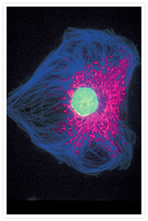Search Thermo Fisher Scientific
Zebrafish retina. ELF® 97 Immunohistochemistry Kit, tetramethylrhodamine wheat germ agglutinin and Hoechst 33342
A transverse section of fixed zebrafish retina probed with FRet 43, a monoclonal antibody that binds to double cone cells, and developed for visualization with enzyme-mediated immunohistochemical techniques using our ELF® 97 Immunohistochemistry Kit (Cat. no. E6600). The yellow-green–fluorescent double cones stained with the ELF® 97 alcohol precipitate are oriented so that their outer segments are at the top of the stained configuration and the synaptic pedicles are at the bottom. This section has been counterstained with tetramethylrhodamine wheat germ agglutinin (Cat. no. W849), which makes the rod outer segments (top left) and the inner plexiform layer and ganglion cell axons (bottom right) appear bright red. Wheat germ agglutinin also binds in the region occupied by the cone outer segments and synaptic pedicles, which appear bright yellow because they are double-labeled with both the ELF® 97 alcohol precipitate and tetramethylrhodamine. Although this section has also been counterstained with Hoechst 33342 (Cat. no. H1399, H3570, H21492), the blue-stained nuclei are barely visible in this photomicrograph. However, the double cones' inner fibers traverse the region occupied by the Hoechst 33342 dye–stained rod nuclei, and thus appear light blue. The inner segments, myoids and nuclei of these double-cone cells are labeled only with the ELF® 97 alcohol precipitate, giving them a characteristic green appearance. The image was obtained by triple-exposure through optical filters appropriate for DAPI, tetramethylrhodamine and the ELF® precipitate. Used with permission from (J Histochem Cytochem 43, 77 (1995)) .

Related Products
Related Images
1% Agarose gel containing 16S and 23S ribosomal RNA (rRNA). SYBR® Green II RNA gel stain. Go ›

Bovine pulmonary artery endothelial cells (BPAEC). MitoTracker® Red CMXRos, SYTOX® Green nucleic acid stain, biotin-XX goat anti–mouse IgG antibody and Cascade Blue® NeutrAvidin biotin-binding protein. Go ›

Prostate carcinoma. Go ›

Transformed mouse fibroblasts (CRE BAG 2 cells). Go ›

A prometaphase muntjac skin fibroblast stained with Alexa Fluor® 350 phalloidin, an anti–a-tubulin antibody and an anti–cdc6 peptide antibody. Go ›

Endothelial cells. Go ›

Mouse Anti-Alpha Tubulin Monoclonal Antibody (Cat. No. A11126) Go ›

Simultaneous detection of expression of five genes in a whole mount Drosophila embryo by fluorescence in situ hybridization (FISH) with five RNA probes Go ›
